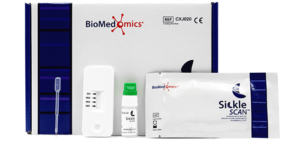Bridging Quality and Care
BioMedomics™ Sickle SCAN® is a multiplexed, qualitative, point-of-care immunoassay to aid in the rapid diagnosis of sickle cell disorders.

The test is made up of three indicators which detect the presence of hemoglobins A, S, and C, allowing the user to rapidly distinguish between normal, carrier, and sickle cell disease samples.
Sickle SCAN® has both a combined sensitivity and specificity of >99% and provides results in 5 minutes, making it one of the fastest and most accurate tests in the world.
Sickle cell disease (SCD) is an inherited blood disorder which often causes red blood cells (RBCs) to become sickle-shaped through the presence of the abnormal hemoglobin S variant. Highly rigid sickle-shaped blood may have difficulty passing through small blood vessels, blocking the normal blood flow, damaging tissues, and ultimately leading to many of the complications of SCD. Additionally, RBCs containing mostly hemoglobin S live only about 16 days compared to 120 days for normal red blood cells. To initiate life-saving therapies, early diagnosis of SCD is key.
Before Sickle SCAN, SCD diagnosis was only possible using complex lab equipment. In low-resource regions where SCD is responsible for 9% of all under-five infant mortality, infrastructure challenges make central lab testing impractical. Sickle SCAN helps overcome the diagnostic gap. Ideal for providing quick and accurate results at the point-of-care, the test requires no supporting equipment and can also be used preventatively for genetic counseling to reduce the incidence of sickle cell births.
The test can be completed in under 5 minutes giving real time results. It uses a small amount of whole blood from a fingerstick, heelstick, or venipuncture.
Compared to traditional central lab testing, Sickle SCAN:



1. Collect a 5 µL blood sample.
2. Mix blood with buffer solution
3. Place 5 drops on test strip and wait 5 minutes.

P. O. Box 5982 Morogoro Road near Dart Kisutu– City Centre
Visiting Hour:
Sunday: 08:00 AM – 10:00 PM
Monday – Friday: 06:00AM – 12:00 AM